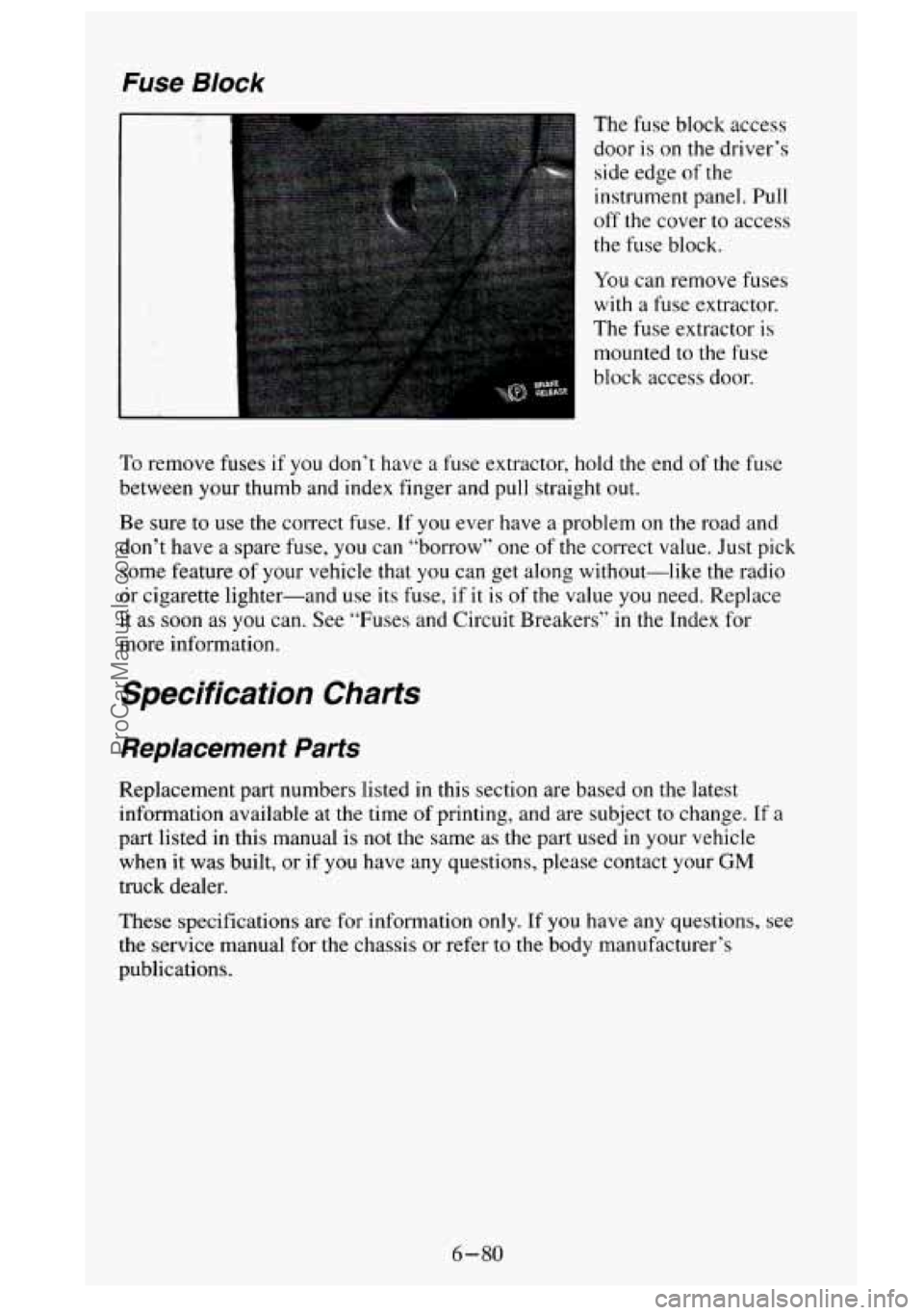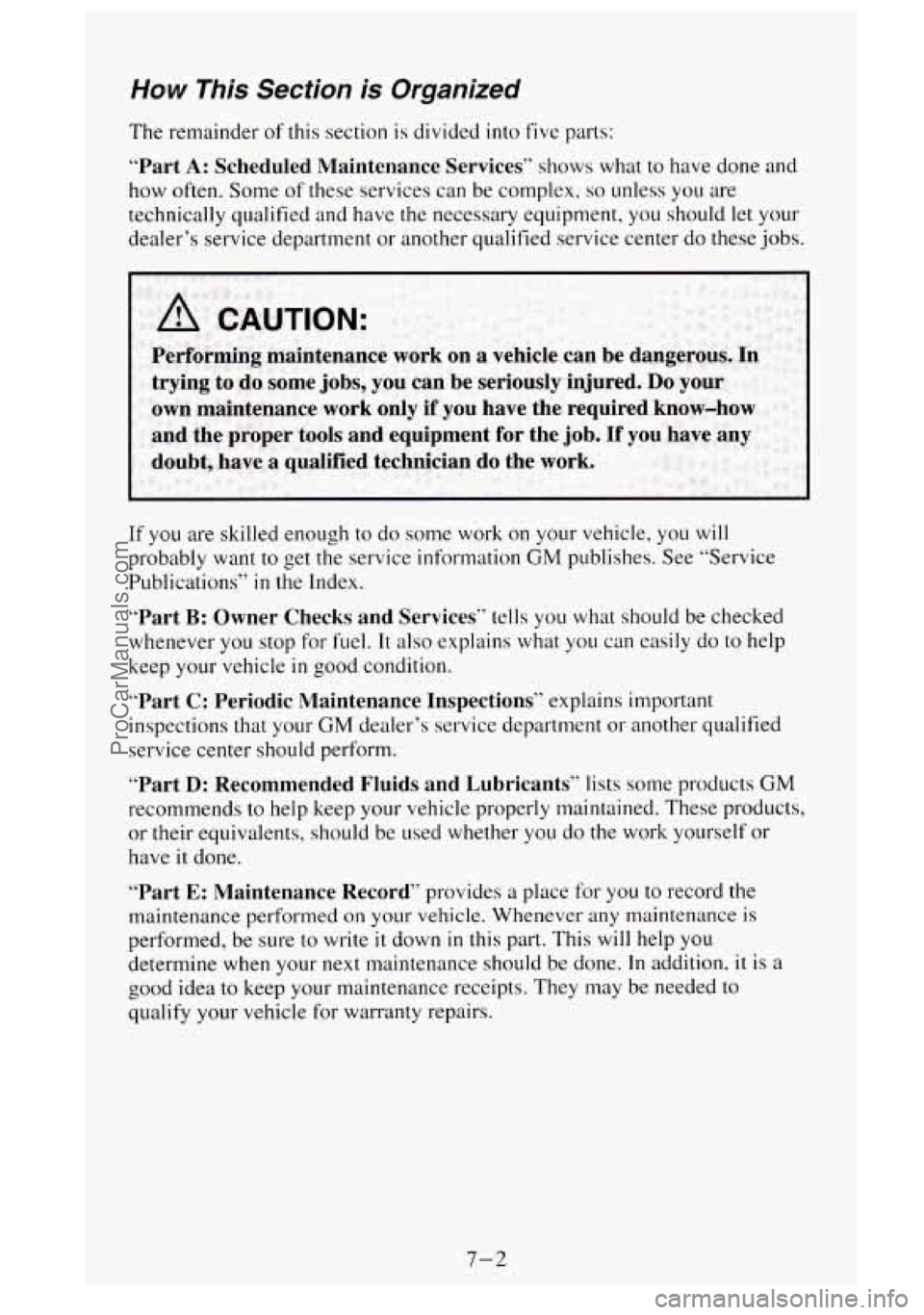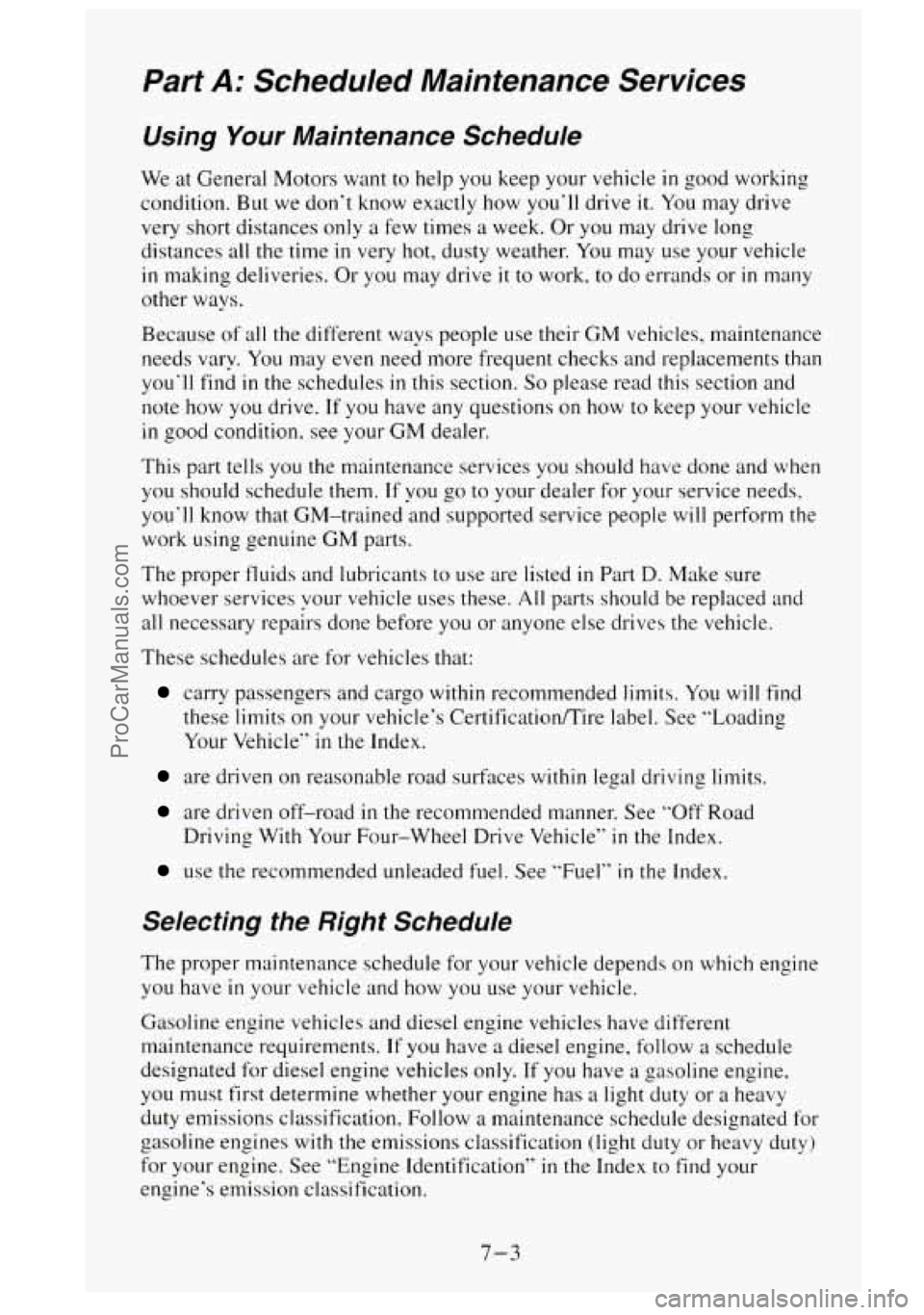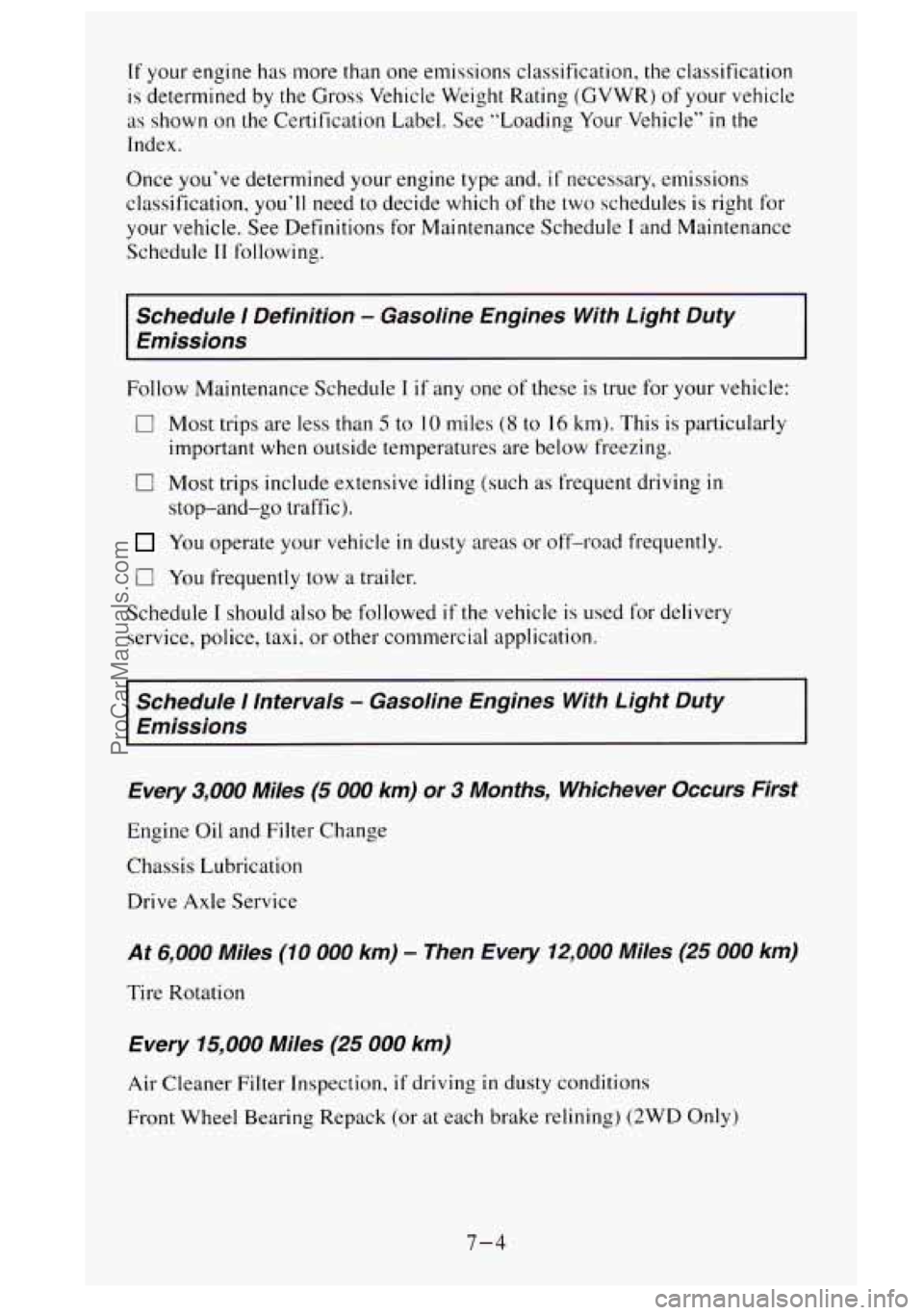Page 344 of 488
Service Parts Identification Label
You’ll find this label on the inside of the glove box.
It’s very helpful if you ever need to order parts. On this label is:
your VIN,
the model designation,
0 paint information, and
a list of all production options and special equipment.
Be sure that this label
is not removed from the vehicle.
Add-on Electrical Equipment
NOTICE:
Don’t add anything electrical to your vehicle unless you check
with your dealer first. Some electrical equipment can damage
your vehicle and the damage wouldn’t be covered by your
warranty. Some add-on electrical equipment can keep other
components from working as they should.
Your vehicle has an air bag system. Before attempting to add anything
electrical to your vehicle, see “Servicing Your Air Bag-Equipped Vehicle”
in the Index.
6-78
ProCarManuals.com
Page 346 of 488

Fuse Block
The fuse block access
door is on the driver’s
side edge
of the
instrument panel.
Pull
off the cover to access
the fuse block.
You can remove fuses
with a fuse extractor.
The fuse extractor is
mounted to the fuse
block access door.
To remove fuses if you don’t have a fuse extractor, hold the end of the fuse
between your thumb and index finger and pull straight out.
Be sure to use the correct fuse. If you ever have a problem
on the road and
don’t have a spare fuse, you can “borrow” one
of the correct value. Just pick
some feature of your vehicle that
you can get along without-like the radio
or cigarette lighter-and use its fuse, if
it is of the value you need. Replace
it as soon as you can. See “Fuses and Circuit Breakers” in the Tndex for
more information.
Specification Charts
Replacement Parts
Replacement part numbers listed in this section are based on the latest
information available at the time
of printing, and are subject to change. If a
part listed in this manual is not the same as the part used in your vehicle
when it was built,
or if you have any questions, please contact your GM
truck dealer.
These specifications are for information
only. If you have any questions, see
the service manual for the chassis or refer
to the body manufacturer’s
publications.
6-80
ProCarManuals.com
Page 350 of 488
Service Replacement Part and Filter
Recommendations
- Gasoline Engines
Engine 4.3L
VTN Z
Oil Filter PFS2
Air Cleaner
A 178CW
Filter
PCV Valve CV789C
Spark
Plugs* .CR43TS
Fuel Filter GF48
1
Radiator Cap
RC36
5.0L
H
PF12183-
A348C
cv774c
.CR43TS
GF48
1
RC36
5.7L
K
PF1218q A348C
cv774c
.CR43TS GF38
1
RC36
+Four Wheel Drive Vehicle
- use a PFS2 oil filter
Wse AC copper-cored resistor type spark plugs
Service Replacement Part and Filter
Recommendations
- Diesel Engines
Engine 6.5L 6.5L
VIN P S
Oil Filter PF1218
PF1218
Air Cleaner A644C
A 1236C
Fuel Filter TP
1006 TP
1 006
Surge
Tank Cap RC33 RC33
7.41
N
PF1218
A348C
cv774c
.CR43TS GF48
I
RC36
6.51
F
PF1218
A 1236C
TP
I006
RC33
6-84
ProCarManuals.com
Page 356 of 488
LAMP OR BULB
INSTRUMENT
PANEL
Daytime Running
Lamps Indicator?
Charging System
Indicator Lamp
Instrument Cluster
Illumination
Headlamp Beam
Indicator
Directional Signal
Indicator
Brake Warning
Indicator
SIR (Air Bag)
Safety Belt Warning
Check Gages Indicator
Malfunction Indicator
(“Service Engine
Soon”) Lamp
Upshift Indicator Glow Plugs Lamp**
Low Coolant Lamp**
Water in Fuel Lamp**
Service Throttle Soon
Lamp**
**Diesel only
“fanadian Vehicles only
TRADE NO.
74
74
194
74
74
74
74
74
74
74
74
74
74
74
74
1
I
6
1
2
1
6-90
ProCarManuals.com
Page 357 of 488
Scheduled Maintenance Services
KEEP ENGINE OIL
AT THE PROPER
LEVEL AND CHANGE
AS RECOMMENDED
Section
This section covers the maintenance required for your vehicle. Your vehicle
needs these services to retain its safety, dependability and emission control
performance.
I protection
Plan
I
Introduction
Your Vehicle and the Environment
Proper vehicle maintenance not only helps to keep your vehicle in good
working condition, but also helps the environment. All recommended
maintenance procedures are important. Improper vehicle maintenance or the
removal
of important components can significantly affect the quality of the
air we breathe. Improper
fluid levels or even the wrong tire inflation can
increase the level of emissions from your vehicle.
To help protect our
environment, and
to help keep your vehicle in good condition, please
maintain your vehicle properly.
7-1
ProCarManuals.com
Page 358 of 488

How This Section is Organized
The remainder of this section is divided into five parts:
“Part A: Scheduled Maintenance Services” shows what to have done and
how often. Some
of these services can be complex, so unless you are
technically qualified and have the necessary equipment, you should let your
dealer’s service department or another qualified service center do these
jobs.
If you are skilled enough to do some work on your vehicle, you will
probably want to get the service information
GM publishes. See “Service
Publications”
in the Index.
“Part B: Owner Checks and Services” tells you what should be checked
whenever you stop for fuel.
It also explains what you can easily do to help
keep
your vehicle in good condition.
“Part C: Periodic Maintenance Inspections” explains important
inspections that your
GM dealer’s service department or another qualified
service center should perform.
“Part D: Recommended Fluids and Lubricants” lists some products GM
recommends to help keep your vehicle properly maintained. These products,
or their equivalents, should be used whether you do the work yourself or
have it done.
“Part E: Maintenance Record” provides a place for you to record the
maintenance performed on your vehicle. Whenever any maintenance
is
performed, be sure to write it down in this part. This will help you
determine when your next maintenance should be done.
In addition, it is a
good idea to keep your maintenance receipts. They may be needed to
qualify your vehicle for warranty repairs.
7-2
ProCarManuals.com
Page 359 of 488

Part A: Scheduled Maintenance Services
Using Your Maintenance Schedule
We at General Motors want to help you keep your vehicle in good working
condition. But we don’t know exactly how you’ll drive it. You may drive
very short distances only
a few times a week. Or you may drive long
distances all the time
in very hot, dusty weather. You may use your vehicle
in making deliveries. Or you may drive it to work, to do errands or in many
other ways.
Because
of all the different ways people use their GM vehicles, maintenance
needs varv.
You may even need more frequent checks and replacements than
you‘ll find
in the schedules in this section. So please read this section and
note how you drive. If you have any questions on how to keep your vehicle
in good condition. see your GM dealer.
This part tells you the maintenance services you should have done and
when
you should schedule them. If you go to your dealer for your service needs,
you’ll know that GM-trained and supported service people
will perform the
work using genuine
GM parts.
The proper fluids and lubricants to use are listed
in Part D. Make sure
whoever services your vehicle uses these.
All parts should be replaced and
all necessary repairs done before you or anyone else drives the vehicle.
These schedules are for vehicles that:
carry passengers and cargo within recommended limits. You will find
these limits on your vehicle’s CertificatiodTire label. See “Loading
Your Vehicle“
in the Index.
are driven on reasonable road surfxes within legal driving limits.
are driven off-road in the recommended manner. See “Off Road
Driving With Your Four-wheel Drive Vehicle”
in the Index.
use the recommended unleaded fuel. See “Fuel” in the index.
Selecting the Right Schedule
The proper maintenance schedule for your vehicle depends on which engine
you have
in your vehicle and how you use your vehicle.
Gasoline engine vehicles and diesel engine vehicles have different
maintenance requirements.
If you have a diesel engine, follow a schedule
designated for diesel engine vehicles only. If you have
a gasoline engine.
you must first determine whether your engine has
a light duty or a heavy
duty emissions classification. Follow a maintenance schedule designated
for
for your engine. See “Engine Identification” in the Index to find your
engine‘s emission classification.
c easoline engines with the emissions classification (light duty or heavy duty)
7-3
ProCarManuals.com
Page 360 of 488

If your engine has more than one emissions classification, the classification
is determined by the Gross Vehicle Weight Rating (GVWR) of your vehicle
as shown on the Certification Label. See “Loading Your Vehicle”
in the
Index.
Once you’ve determined your engine type and,
if necessary, emissions
classification, you’ll need to decide which of the two schedules is right for
your vehicle. See Definitions for Maintenance Schedule
I and Maintenance
Schedule
I1 following.
Schedule I Definition - Gasoline Engines With Light Duty
Emissions
Follow Maintenance Schedule I if any one of these is true for your vehicle:
iII Most trips are less than 5 to 10 miles (8 to 16 km). This is particularly
important when outside temperatures are below freezing.
0 Most trips include extensive idling (such as frequent driving in
stop-and-go traffic).
You operate your vehicle in dusty areas or off-road frequently.
0 You frequently tow a trailer.
Schedule
I should also be followed if the vehicle is used for delivery
service, police, taxi, or other commercial application.
Schedule I Intervals - Gasoline Engines With Light Duty
Emissions
Every
3,000 Miles (5 000 km) or 3 Months, Whichever Occurs First
Engine Oil and Filter Change
Chassis Lubrication
Drive Axle Service
At 6,000 Miles (10 000 km) - Then Every 12,000 Miles (25 000 km)
Tire Rotation
Every 75,000 Miles (25 000 km)
Air Cleaner Filter Inspection, if driving in dusty conditions
Front Wheel Bearing Repack
(or at each brake relining) (2WD Only)
7-4
ProCarManuals.com